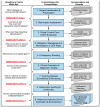Biosecurity and Vaccines for Emerging Aquatic Animal RNA Viruses
- PMID: 40573359
- PMCID: PMC12197387
- DOI: 10.3390/v17060768
Biosecurity and Vaccines for Emerging Aquatic Animal RNA Viruses
Abstract
Emerging RNA viruses pose a critical threat to aquatic animals, leading to significant ecological and economic consequences. Their high mutation rates and genetic adaptability drive rapid evolution, cross-species transmission, and expanding host ranges, complicating disease management. In aquaculture, RNA viruses are responsible for major outbreaks in fish, while DNA viruses predominate in crustaceans. Marine mammals are increasingly affected by morbilliviruses and highly pathogenic avian influenza (HPAI) H5N1, which has caused widespread mortality events in pinniped and cetacean populations, raising concerns about zoonotic spillover. The absence of effective antiviral treatments and the complexity of vaccine development highlight the urgent need for enhanced biosecurity measures. Furthermore, novel vaccine approaches, such as self-assembling protein nanocage platforms, offer promising solutions for RNA virus mitigation. This review provides a comprehensive analysis of the emergence and significance of RNA viruses in aquatic animals over the last two decades, with a particular focus on biosecurity and vaccine development.
Keywords: RNA viruses; aquaculture; biosecurity; marine mammals; vaccines; viral emergence.
Conflict of interest statement
The authors declare no conflicts of interest.
Figures




Similar articles
-
Aquatic circoviruses: emerging pathogens in global aquaculture - from discovery to disease management.J Virol. 2025 Jan 31;99(1):e0173724. doi: 10.1128/jvi.01737-24. Epub 2024 Dec 13. J Virol. 2025. PMID: 39670743 Free PMC article. Review.
-
Viral Threats to Australian Fish and Prawns: Economic Impacts and Biosecurity Solutions-A Systematic Review.Viruses. 2025 May 10;17(5):692. doi: 10.3390/v17050692. Viruses. 2025. PMID: 40431703 Free PMC article. Review.
-
Highly Pathogenic Avian Influenza (H5N1) Clade 2.3.4.4b in Cattle: A Rising One Health Concern.Animals (Basel). 2025 Jul 3;15(13):1963. doi: 10.3390/ani15131963. Animals (Basel). 2025. PMID: 40646862 Free PMC article. Review.
-
mRNA Vaccine Development in the Fight Against Zoonotic Viral Diseases.Viruses. 2025 Jul 8;17(7):960. doi: 10.3390/v17070960. Viruses. 2025. PMID: 40733577 Free PMC article. Review.
-
Emergence and Evolution of Novel Reassortant Influenza A Viruses in Canines in Southern China.mBio. 2018 Jun 5;9(3):e00909-18. doi: 10.1128/mBio.00909-18. mBio. 2018. PMID: 29871917 Free PMC article.
References
-
- Dadar M., Dhama K., Vakharia V.N., Hoseinifar S.H., Karthik K., Tiwari R., Joshi S.K. Advances in Aquaculture Vaccines Against Fish Pathogens: Global Status and Current Trends. Rev. Fish. Sci. Aquac. 2017;25:184–217. doi: 10.1080/23308249.2016.1261277. - DOI
Publication types
MeSH terms
Substances
LinkOut - more resources
Full Text Sources

